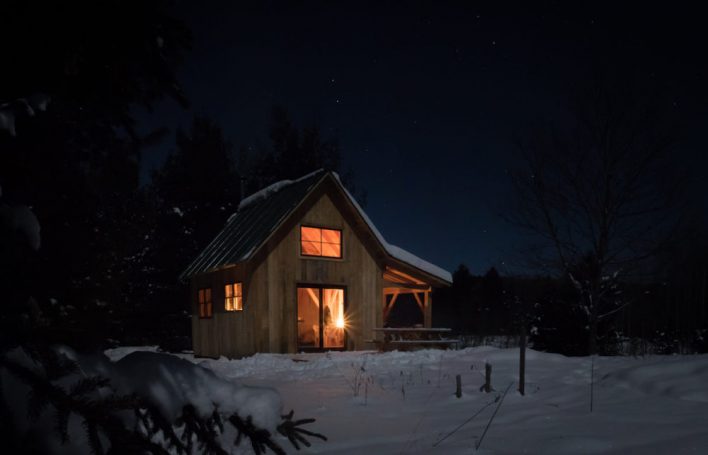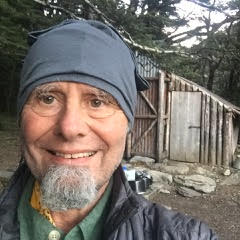Though hut-to-hut opportunities in the U.S. are limited compared with Europe and New Zealand, American hut systems are growing in number and popularity. About 27 systems in the U.S. support traverses of four or more days, sheltering visitors in nearly 170 huts with a total of about 2,200 beds. In our book, Hut to Hut USA: the complete guide for hikers, bikers and skiers, Laurel Bradley and I identify a dozen grassroots initiatives in various stages of construction, planning or dreaming. As Americans begin to think and act imaginatively about huts, the number, variety and purpose of hut-to-hut experiences will expand greatly. Looking to the future, I feel both hope and trepidation.
My fear is that as America embraces huts, we won’t be able to resist our inclination toward commercializing, motorizing and glamping. Will we make huts part of the problem or strengthen them as part of the solution to humans ravaging the Earth?
I hope that after being a pioneer in wilderness preservation, car camping and backpacking, America is poised to contribute creatively to enhanced development of huts for conservation, recreation, education and spiritual development. Hut systems here will increase in number and reach; they will remain rustic and affordable; they will be optimized to protect wild lands and accessibility. This vision extrapolates from the remarkable work already happening with U.S. huts.

Conservation
When our decentralized land management agencies finally take stock of their decades of permitting hundreds of huts on public lands, they will begin to understand that huts are environmental stewardship tools. Land managers and hut owners will connect with operations around the world, learning from their successes and mistakes. The U.S. Hut Alliance’s national best practices will guide development of a new generation of hut and trail systems. Teams of international and American hut practitioners will build a series of experimental huts in the U.S. based on workshops and design labs that generate innovative ideas for green, 21st century development.
As human impacts continue undermining our vast public land’s ecological integrity, regulations on access will become increasingly necessary. Building on the research of recreation ecologist Dr. Jeffrey Marion, which proves empirically that huts minimize adverse impacts of overnight backcountry trips, huts will figure in long-range conservation and recreation plans on all levels. Permanent and portable huts will be deployed to change front- and backcountry use patterns, directing people away from fragile and overused areas. With advancing climate change, huts will be base camps for citizen science programs and hands-on conservation work. Trekkers will gladly “pay” for the privilege of hut-to-hut journeys by volunteering for conservation projects.
Recreation
U.S. hut systems are mostly in mountainous backcountry; they will expand into other terrain. I envision networks of frontcountry huts closer to urban and suburban centers, where 80 percent of Americans live. Many will be on lands tarnished by humans and in need of protection and restoration. Connected to existing parks and trails, public transportation will serve some hut-to-hut trailheads. Hut systems will be thoughtfully shaped to welcome user groups underrepresented in our great wild places, including African Americans, Latinos and the Asian American and Pacific Islander community. They will be affordable portals to the natural world for urban communities eager to relearn outdoor skills and reconnect with the healing balm of trees, grass, rocks and waterways.
European style village-to-village trekking will flourish, providing steppingstones from the city to the frontcountry and beyond. Contributing to rural economies, people will complete multiday traverses using local lodging and eateries without the need for advanced outdoor skills.
Long-distance hut-to-hut travel will finally come to our vast continent as America begins to place dozens of huts at regular intervals on its many long-distance trails. Versions of Benton MacKaye’s full 1921 vision for the Appalachian Trail will finally be realized (though probably not on the AT!). See “Sam’s Hut Dreams,” the final chapter in our book, for a 21st century vision of what this might look like.
Education, Therapy and Spiritual Growth
Nature immersion experiences are touchstones of many forms of spirituality and healing. As America redoubles its efforts to cultivate an ethos of biophilia, hut-based educational and therapeutic programs will expand. Hut-to-hut journeys will address “nature deficit disorder” while teaching outdoor skills, natural history and simple green living. Community organizations will partner with operators to use huts as learning labs in the wild and develop new generations of outdoor citizens.

Hut systems will support new generations of environmental pilgrims updating civilizational practices such as ritual journeys of redemption and spiritual renewal, and rites of passage. We will see the development of secular, distinctly American pilgrimage trails dedicated to veneration of nature and personal growth and reflection. The use of huts as effective therapeutic venues for veterans and others suffering post-traumatic stress disorder, and for programs benefitting underserved populations, will continue to grow. Healing conversations among polarized groups will be nurtured in huts. Hunters and hikers, to cite one obvious example, have diverged in recent generations. United by a love of the outdoors, folks from seemingly opposed camps will convene in rustic huts to rediscover common ground in protecting the Earth and each other.
While huts and trails will not save the world, an interconnected web of simple shelters will become sustainable infrastructure for reconnecting people to nature and each other. Simple huts—the original form of human habitation—might just help humanity resituate itself in the web of life.
Sam Demas is editor of hut2hut.info and the author, along with Laurel Bradley, of Hut to Hut USA: the complete guide for hikers, bikers and skiers, published by Mountaineers Books in 2021.
This story originally published in Backcountry No. 144, The Backyard Issue. To snag a copy, click here or subscribe.










Related posts: